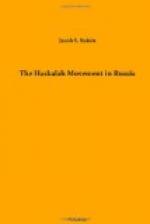Warsaw, too, was a beneficiary of Germany, having been occupied by the Prussians before it fell to the lot of the Russians. It was there that practically the first Jewish weekly journals were published in Yiddish and Polish, Der Beobachter an der Weichsel, and Dostrzegacz Nadvisyansky (1823). There was opened the first so-called rabbinical seminary, with Anton Eisenbaum as principal, and Cylkov, Buchner, and Kramsztyk as teachers. The public schools were largely attended, owing to the efforts of Mattathias Rosen, and a year after a reformed synagogue had been organized in Odessa another was founded in Warsaw, where sermons were preached in German by Abraham Meir Goldschmidt.
But Riga on the Baltic, Odessa on the Black Sea, and Warsaw on the Vistula were outdone by some cities in the interior. Haskalah lovers multiplied rapidly, and were found in the early “forties” in every city of any size in the Pale. “The further we go from Pinsk to Kletzk and Nieszvicz,” writes a correspondent in the Annalen,[29] “the more we lose sight of the fanatics, and the greater grows the number of the enlightened.” With the establishment of the rabbinical seminaries in Zhitomir (1848), this former centre of Hasidism became the nursery of Haskalah. The movement was especially strong in Vilna, the “Jerusalem of Lithuania,” as Napoleon is said to have called it. From time immemorial, long before the Gaon’s day, it had been famous for its Talmudic scholars. “Its yeshibot,” says Jacob Emden in the middle of the eighteenth century, “were closed neither by day nor by night; many scholars came home from the bet ha-midrash but once a week. They surpassed their brethren in Poland and in Germany in learning and knowledge, and it was regarded of much consequence to secure a rabbi from Vilna.” Now this “city and mother in Israel” became one of the pioneers of Haskalah, all the more because, in addition to the public schools and the rabbinical seminary, the Jews were admitted to its university on equal terms with the Gentiles. “Within six years,” exclaims Mandelstamm, “what a change has come over Vilna! Youths and maidens, anxious for the new Haskalah, are now to be met with everywhere, nor are any ashamed to learn a trade.” The schools exerted a salutary influence on the younger generation, and the older people, too, began to view life differently, only that they were still reluctant to discard their old-fashioned garb. There also, in 1847, the leading Maskilim started a reform synagogue, which they named Taharat ha-Kodesh, the Essence of Holiness.[30]




